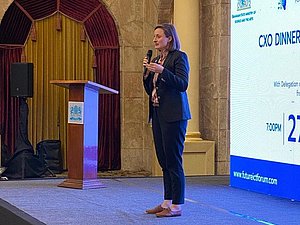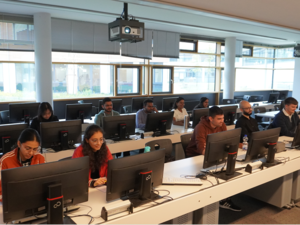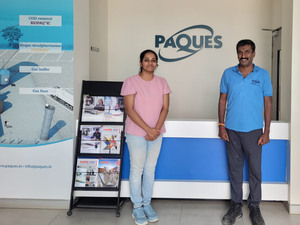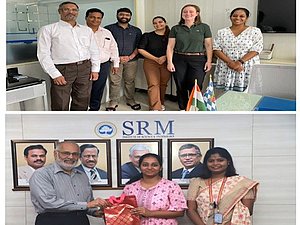The pharmIn2 project funded by the German Federal Ministry for the Environment, Nature conservation, Nuclear saftey and Consumer protection (BMUV) under the funding programme Export Initiative for Environmental protection intends to export and promote a novel wastewater treatment technology to effectively treat the challenging wastewater generated by the pharmaceutical industry in India.
ObjectivesBackgroundtechnology Publications NewsPartnersContact
Objectives
The goal of the project pharmIn2 is to export an innovative wastewater treatment technology a3op® developed by project partner up2e! to effectively treat the challenging wastewater generated by the pharmaceutical industry in India.
The target group includes pharmaceutical companies in India, central wastewater treatment plants, service providers public institutions and universities. Through the development of an E-learning-based information and training platform, various operator models and the participation in trade fairs and information events, the project aims to create the necessary framework conditions for establishing state-of-the-art technology in the field of wastewater treatment as a new environmental standard in India.
The Bavarian-Indian Center for Business and University Cooperation (BayIND) will bring in its long-standing experience in working with decision-makers at the government level, in universities, from industry leaders and global experts in the environmental sector in India.
Background
Antimicrobial resistance (AMR) is a looming pandemic necessitating urgent intervention to avoid potentially catastrophic consequences. The injudicious employment of antimicrobials in the human, animal and environmental sectors is one of the key factors driving AMR. The environment plays a pivotal role for AMR through transfer of resistance genes from environmental microbes to pathogenic species and selection of resistant organisms in the presence of antimicrobial contamination of soil and waterbodies. This in turn may result in the unintended exposure of both human and animal populations to these resistant microbial strains, independently of direct antimicrobial consumption.
Furthermore, pharmaceutical industrial effluents, containing antimicrobial residues, emerge as potential conduits for the introduction of such substances into the environment. Research conducted across diverse geographical contexts, encompassing nations such as India, has substantiated the presence of substantial quantities of antibiotic remnants (ARs) within pharmaceutical effluents (PE). Notably, prevailing regulatory frameworks, both at the national and international levels, lack definitive guidelines pertaining to the effluent treatment for antibiotics or acceptable levels of ARs in effluents. It is noteworthy that pharmaceutical effluents house non-biodegradable organic compounds, exerting pronounced ecotoxicity on aquatic ecosystems and human well-being. 60-80% of prescription drugs are excreted and end up in wastewater treatment plants and the environment.
India's pharmaceutical sector holds the 3rd spot globally in terms of production volume and ranks 14th in terms of production value. Notably, it stands as the primary global source of generic medications. The comprehensive involvement of the Indian pharmaceutical market spans across all stages of production, encompassing Active Pharmaceutical Ingredients (API), Pharmaceutical Formulation Intermediates (PFI), and Finished Dose Products (FDP). This industry landscape comprises over 3000 pharmaceutical enterprises, spanning varying sizes from small-scale to medium, large, and multinational corporations.
However, a significant concern arises from the discharge of effluents containing substantial antibiotic concentrations from pharmaceutical manufacturing plants. This discharge leads to the contamination of rivers and lakes, with the Musi River in Hyderabad being a striking example. This southern Indian city, housing almost 10 million residents, witnesses the Musi River turning into a chemical-laden watercourse due to untreated wastewater disposal from the pharmaceutical sector.
India is a major producer of 34 cost-effective antibiotics and other medications destined for the global market, including Europe, with this trend on the rise. A growth rate of 10-12% projects the Indian pharmaceutical industry to achieve sales nearing US$130 billion by 2030. However, the repercussions for society and the environment come at a steep cost. The country faces the dual challenge of being severely affected by climate change while heavily relying on rainfall. Simultaneously, water quality deteriorates due to significant pollution, where the pharmaceutical industry emerges as a notable contributor. Recent investigations highlight the presence of pharmaceutical residues in Hyderabad's lakes, rivers, and wells. While the measured pharmaceutical concentrations ranged from 90 to 31,000 μg dm-3, the cumulative and long-term exposure to these compounds may lead to chronic effects.
In 2018, the National Centre for Disease Control (NCDC) of India expressed concerns regarding the contamination of water sources by antibiotics and urged the environment ministry to establish and enforce stringent regulations for the proper disposal and effective treatment of antibiotic waste. The Indian Ministry of Environment categorized all pharmaceutical manufacturers as 'red category,' indicating their release of toxic and hazardous pollutants into the environment. The Central Pollution Control Board (CPCB) of India responsible for overseeing environmental compliance, has been assigned the task of setting limits for the discharge of antibiotic waste from production processes. Traditional wastewater treatment facilities have shown limited efficiency in eliminating pharmaceutical residues, primarily due to the presence of complex active organic compounds that resist breakdown. Furthermore, antibiotics present in pharmaceutical effluents have been found to be detrimental to the microorganisms within treatment plants, thereby diminishing overall treatment efficiency.
Recent shifts in Indian legislation are amplifying the pressure on pharmaceutical manufacturers to adopt appropriate practices in drug production. One such initiative is the proposed implementation of Zero Liquid Discharge (ZLD) specifically for the production of Active Pharmaceutical Ingredients (APIs) and bulk drugs. This approach focuses on mitigating the emergence of multi-resistant bacteria. Additionally, forthcoming regulations will mandate industries with problematic effluents to undergo Advanced Oxidation Process (AOP) treatment before discharging wastewater. The incorporation of AOP in wastewater treatment would enable the Indian pharmaceutical industry to safely release treated wastewater post the drug manufacturing process. In alignment with broader environmental goals, the Indian government has outlined a target of achieving a net-zero carbon footprint by 2070. Pharmaceutical manufacturers are now required to submit plans outlining strategies for reducing their carbon emissions. The technology addressed in this project will effectively support the implementation of the government's targets.
The main target sectors are the pharmaceutical, chemical and textile industry as well as wastewater treatment plants.
a3op® Technology by up2e!
What is a3op® technology?
Our partner company up2e! developed the proprietary Roturi® gas-mass-transfer technology that achieves a direct ozone dissolution and thus a highly efficient and quick gas transfer to the medium. For specific applications it is combined with the introduction of acoustic energy, creating an Acoustically Activated Advanced Oxidation Process (a3op®) with increased reaction kinetics. Being a platform technology, it can be adapted to existing plant configurations, wastewater conditions and treatment goals. Amid those features, the a3op® platform technology can always be extended by adding individual key modules or treatment lines to address an increase in production and related rise in water volumes.
Advantages
| Time saving installation and commissioning | The a3op® platform comes as a pretested, either skid-mounted or containerized ready-to-operate unit. This makes retrofitting or new installations not only easy but also highly time efficient. |
| Safe operation | The Roturi operates in the main pipe system and flow. Ambient pressure and temperature lead to a safe, reliable and easy to control operation. |
| Modular design | The entire solution is set-up as a modular design. It can easily and quickly be adjusted to individual needs and wastewater profiles. Variations in flow rate or changes in load parameters can be addressed instantly. Design creates a larger surface and hence immediate gas transfer is possible and hence no clogging or scaling is formed. |
| Reduced energy and operational costs | The smaller the pressure difference the longer the bubble remains in the solution, and hence the gas losses are less resulting in reduction of operational expenses. Precise dosing of controlled gas to liquid setting reduces ozone and oxygen demand and energy requirements. |
| Small footprint | Compared to conventional diffusors of basin depth greater than 6m, the Roturi technology due to its inline dosing, results in smaller CO2 footprint. Conventional diffusors with concrete basin structures also results in sealing of surface areas whereas Roturi technology with its inline dosing prevents surface sealing. |
Sustainable Development Goals 2030 (SDG 2030)
The project focuses on the sector of "water supply and wastewater management" within the export program. Its aim is to aid the market introduction of Up2e! Company's innovative wastewater treatment technology, designed to align with specific Sustainable Development Goals (SDGs) outlined in the 2030 Agenda. This technology advancement directly contributes to enhancing water quality, thereby targeting the achievement of the following Sustainable Development Goals:










![[Translate to English:] [Translate to English:]](/fileadmin/_processed_/4/8/csm_Picture1_956877ed1e.jpg)

![[Translate to English:]](/fileadmin/_processed_/2/d/csm_WhatsApp_Image_2023-11-28_at_5.41.56_AM_86ec97a62f.jpeg)


![[Translate to English:] [Translate to English:]](/fileadmin/_processed_/5/f/csm_musi_new_44dea11e50.jpg)





